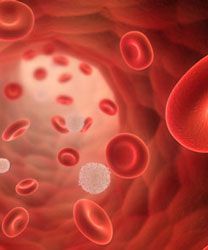MDS, AML Risks Rise Significantly Following Chemotherapy in Most Solid Cancers
The first attempt to quantify therapy-related myelodysplastic syndrome or acute myeloid leukemia in the era of widespread platinum-based chemotherapy has found that tMDS/AML risks were statistically significantly elevated after chemotherapy for 22 of 23 solid cancers, according to a new study in <em>JAMA Oncology.</em>

The first attempt to quantify therapy-related myelodysplastic syndrome or acute myeloid leukemia (tMDS/AML) in the era of widespread platinum-based chemotherapy has found that tMDS/AML risks were statistically significantly elevated after chemotherapy for 22 of 23 solid cancers, according to a new study inJAMA Oncology.1
“Our results provide what we believe to be the first clear evidence of excess tMDS/AML risks following chemotherapy for oral cavity or pharynx, esophagus, stomach, rectum, larynx, bone, cervix, uterine corpus, and vagina or vulva cancers, with risk estimates based on 14 or more tMDS/AML cases after each first primary cancer except the vagina or vulva,” wrote the authors, led by Lindsay M. Morton, PhD, of the National Cancer Institute. “For each of these sites, platinum compounds have been introduced to improve outcomes.”
To quantify tMDS/AML risk after chemotherapy for solid cancer among US adults since 2000, Morton et al conducted a population-based cohort study using cancer registries from the Surveillance, Epidemiology, and End Results (SEER) Program and Medicare claims. They noted that, because the registry data included large numbers of unselected chemotherapy patients and systematic long-term patient follow-up, they were able to compare tMDS/AML incidence among patients treated with chemotherapy with the general population to estimate relative and absolute risks.
The study population consisted of 700,612 US adults aged 20-84 years whose first primary solid cancer was diagnosed during 2000-2013 and who survived 1 year or more without developing a second cancer. Patients were followed beginning 1 year after the first primary cancer diagnosis until a second cancer diagnosis, death, age 85 years, loss to follow-up, or the end of the study on December 31, 2014.
Within the study population, there were 1619 tMDS/AML cases in the SEER database, with 70.9% of patients being female with an average age of 64.3 years. The authors quantified the relative risks as ranging from 1.5 to greater than 10. They also quantified the excess absolute risks as ranging from 1.4 to greater than 15 cases per 10,000 person-years compared with the general population.
The tMDS/AML risks were not significantly elevated after chemotherapy for colon cancer overall (standardized incidence ratio [SIR], 1.1; 95% CI, 0.9-1.3). Between 2007 and 2014, 28 cases of tMDS/AML were reported (SIR, 1.2; 95% CI, 0.8-1.8).
The paper reported that SIRs were 5- to 9-fold significantly elevated following chemotherapy for peritoneum, small cell lung, ovary, fallopian tube, and brain or central nervous system cancers. SIRs were 1.5-fold to 4-fold significantly elevated following chemotherapy for the remaining cancers.
The post-chemotherapy relative risks were the highest after chemotherapy for bone cancer (SIR, 39.0; 95% CI, 21.4-65.5). Patients with testicular cancer faced the second-highest relative risk (SIR, 12.3; 95% CI, 7.6-18.8). Soft tissue cancers had the third-highest relative risk (SIR, 10.4; 95% CI, 6.4-15.9). As expected, these cancers were typically diagnosed in younger patients.
Overall survival (OS) following tMDS/AML diagnosis was poor. Of the 1619 patients who developed tMDS/AML, 1270 died (78.4%). These patients had a median OS of 7 months.
Registry data do not include treatment details, so the authors also used the SEER-Medicare database, which lists the chemotherapy agents for each patient. They found that the use of known leukemogenic agents, particularly platinum compounds, in initial chemotherapy increased substantially since 2000. “[But] our analysis could not directly estimate tMDS/AML risk associated with these drugs,” Morton et al wrote.
The paradigm shift in treatment was most notable for gastrointestinal tract cancers: In 2000-2001, only 10% of these patients received platinum-based treatment, but that number had ballooned to 81% by 2012-2013.
Morton et al’s results raise the question as to why colorectal cancer rates were not affected. “It is unknown whether the lower SIRs that we observed after rectal and colon cancers reflect lower leukemogenicity of oxaliplatin owing to variation in myelotoxic effects among the different platinum compounds or the need for further follow-up because oxaliplatin was not widely used for these cancers until the latter portion of our study period,” they wrote.
The authors note several limitations of their study, the most important of which are “the lack of data on chemotherapy agents and doses for individual patients as well as lack of data on subsequent therapy,” they wrote. “The exact magnitude of our risk estimates, including the proportions of excess cases, should therefore be interpreted cautiously.”
Morton et al project that, for patients who are being treated with chemotherapy as of late 2018, approximately three-quarters of tMDS/AML cases expected to occur within the next 5 years will be attributable to chemotherapy.
Morton et al believe their work highlights an important knowledge gap in oncology. “Although the absolute risk of developing tMDS/AML is low, its treatment is often resource intensive and associated with substantial morbidity; overall survival is poor, highlighting its clinical significance,” they wrote. “Treatment risk and benefit assessments should balance tMDS/AML risks and other chemotherapy-related adverse effects against potential gains in survival, particularly for patients with a favorable prognosis. Continued efforts to develop effective and less toxic chemotherapeutic approaches are needed.”
Reference:
Morton LM, Dores GM, Schonfeld SJ, et al. Association of Chemotherapy for Solid Tumors With Development of Therapy-Related Myelodysplastic Syndrome or Acute Myeloid Leukemia in the Modern Era.JAMA Oncol.Published Online: December 20, 2018. doi:10.1001/jamaoncol.2018.5625
Novel Approaches Focus on Limiting Toxicity in Older Patients With ALL
April 22nd 2024The major challenges for clinicians treating older patients with acute lymphoblastic leukemia surround the emergence of resistance to existing therapies and the toxicities associated with current chemotherapies.
Read More